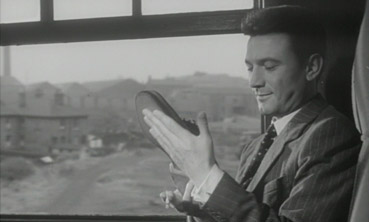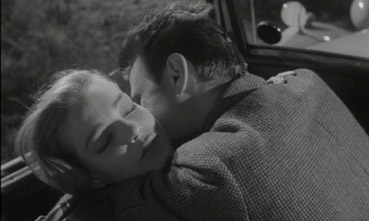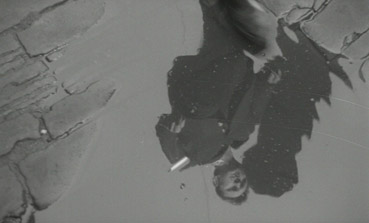| "We pride ourselves on being civilized here in Warnley." |
| Mr Hoylake's cheap shot to Dufton's finest |
A piercing whistle announces the arrival of Joe Lampton in Room at the Top's unforgettable opening take. Whilst the chimney stacks and canals of industrial northern England shoot past in the background, Joe slips on his new shoes over tattered socks, removes the newspaper covering his face and then cheekily turns away from the camera before we can properly see him. This is the debut of a new type of cinematic protagonist for a new Britain, the angry young man, the working class anti-hero who knows what he wants and will do anything to get it. Room at the Top gave audiences this character at the same time as it gave them a new type of film; x-rated, class-ridden, dark, unembarrassed of swearing and frank about sex. Its a terrific film that's finally getting a decent DVD release.
Laurence Harvey stars as Joe Lampton, a working-class clerk from Dufton who moves to Warnley to take up a position in the treasury department. Realizing his opportunities at the department are limited, he sets his sights on Susan Brown (Heather Sears), daughter of a local industrialist. His attempts to seduce Susan are complicated by a simultaneous affair with a middle-class French woman, Alice (Simone Signoret). As Joe's affairs continue events begin to overtake him, and his ambitions result in a devastating climax.

Rightly heralded as the film that kicked off the British New Wave, Room at the Top laid the ground for other kitchen sink films such as Loneliness of the Long Distance Runner and This Sporting Life. It is a film that is obsessed with class, particularly the image of class and how people from the different classes see each other. The film was made at a time when Britain's class boundaries were beginning soften, though not completely melt away, and the working class itself was beginning to split between the 'blue collar' manual labourers (Arthur Seaton in Saturday Night and Sunday Morning) and the 'white collar' social climbers (Vic Brown in A Kind of Loving). Joe Lampton graduates from blue collar Dufton to white collar Warnley within the first 2 minutes of the film; his ultimate ambition is the fashionable middle class district called 'the Top', and the social change that implies. Although Joe professes to be proud of his background, his sole motivation throughout the film is to move on and find something better, eager to shed his working-class status. Audiences of the fifties would have been used to seeing the cinema representing the class divide only in the 'officers above, crew below' format of the war film, Room at the Top has an honesty about British society that would have been refreshing (that war dynamic is played upon here, as Joe's upper-crust rival Jack Wales repeatedly refers to him as 'Sergeant'). Likewise its treatment of sex and swearing, though tame by today's standards, would have been quite novel at the time, showing sex as an enjoyable act was something rare in British cinema, as was the authenticity of the language. The film is similarly honest about social mobility: it has only one working-class success story (wealthy mill owner Mr Brown), and it is made clear that the only way for Joe to break into the middle class is by manipulation, seduction and ruthlessness. Although primarily concerned with class, Room at the Top doesn't subscribe to the social realist doctrine that the later kitchen sink films do, favouring a much more conventional plot. The film has a slightly episodic structure more suited to its literary origins, and the presence of two competing lovers, one offering true happiness and the other wealth and status perhaps lead the film to a somewhat foreseeable climax. Otherwise Room at the Top is a gripping story with a deliberate pace that is successful largely because it focuses entirely on its entirely unsympathetic anti-hero.
Joe himself is the perennial outsider, so it is fitting that he's played to near-perfection by Laurence Harvey, who is something of an outsider himself. A Lithuanian actor (born Hirsh Skikne) educated in South Africa and then at RADA, Harvey seems an odd choice to play the working-class hero Joe. His accent is certainly a point of contention, but then again many of the English supporting actors such as Donald Houston and Richard Pasco don't quite manage it either. His physical appearance also makes him stand out: strikingly tall and thin with spiky hair, for the film's first half he is a wiry mass of arachnid movement, constantly moving and touching the set. Harvey acts with a great deal of conviction that makes Joe's ambition believable: when he sees Susan Brown getting into a sports car at the start of the film, he pronounces 'that's what I'm going to have' with such certainty that you don't doubt him for a second. Likewise there is a lot of subtlety at work in Harvey's performance, such as a scene in which he attends a civic ball, adjusting his tuxedo on the way that betrays a gap in Joe's confidence in so small a way as to be nearly unnoticeable. Whilst it isn't a powerful angry performance in the way of Albert Finney in Saturday Night and Sunday Morning, and doesn't carry the authenticity of northern England in the way that a local actor might, Harvey nails Joe's slimy ambitions and curious outsider status perfectly (the scene in which he emptily confesses his love to Susan is a brilliantly measured piece of work; she's taken in, we aren't.) Harvey plays opposite Simone Signoret as Alice, the role for which Signoret took that year's Oscar for best actress, and it is well deserved. Signoret's is by far the best performance of the film, firely defying Joe's sexist rant about her nude photograph in one scene, quietly subduing to her husband's impromptu demand for her car keys in another. Her final moments onscreen, as she drunkenly contemplates her affair with Joe alone in a quiet pub, are extremely effective and some of the best understated work ever seen in British cinema. Signoret's performance is all small gestures and glances, Harvey's is constant rhythmic movement: the two are electrifying together. The rest of the cast contribute to a tapestry of great performances, Donald Wolfit as self-made man Mr Brown embodies the role entirely, investing the lines with weight and conjuring a back story from the scantest of information (his wife's assertion that Joe is a 'small town nobody' is met with 'small town nobodies sometimes do well enough. You saw nowt wrong with one once, mother' that tells us everything). Donald Houston is reliable as ever as Joe's flatmate Charlie, and John Westbrook and Allan Cuthbertson are on top form as Joe's middle and upper class rivals. There is also an early cameo from Derren Nesbitt, who has a great close up as he lights a cigarette before punching Joe in the face.

Director Jack Clayton emphasizes the exterior nature of class performance by filling his scenes with windows, doorways and mirrors; characters are constantly being reflected or framed as if in a painting. Likewise there are lots of repeated gestures (listen to Neil Styman's excellent DVD commentary to get all of these), plot foreshadowing and metaphor that carry the film over into melodrama in certain moments. The film actively embraces this, and the drabness of the Warnley setting (as well as the bombsite Dufton) are somewhat perfunctory, places that show Joe's social progression but little else. Aesthetically Clayton and cinematographer Freddie Francis imbue the scenes with lingering sensuality, particularly those concerned with Alice (the way the soft light picks out her blonde hair or the smoke from her cigarette), and even the darker moments are peppered with an almost chiaroscuro setup that are a world away form the more naturalistic approaches taken by the later New Wave directors. Clayton retains a tight control over his framing and blocking, especially noticeable in scenes such as the one at the theatre in which Clayton marshals large numbers of his key players, following them as they break off into smaller groups, move in and out of rooms and direct sly looks at each other; Clayton even manages to place a mirror in the take that shows Alice looking a Jack's reflection as he ascends some stairs. It is a remarkable piece of work that is a testament to Clayton's directorial skill.
It's impossible not to see Room at the Top in relation to what followed it, and doing so highlights its strangeness in film history; the gunshot announcing the start of the New Wave, not really fitting into the movement itself. The film itself is terrific, full of fine performances and masterly direction; time may have dulled some of its edge but none of its impact.
A 1.66:1 transfer that may lack anamorphic enhancement but in all other respects is a winner and has clearly undergone careful restoration. The print is strikingly clean and the tonal range of the monochrome picture just right, sacrificing just a little in the black levels to provide better shadow detail. The picture does feel a little bright in some scenes, but this could well be part of its original look. The detail level is impressive throughout.

A clean and clear mono soundtracktrack with the expected restrictions on dynamic range. If you're re-directing bass through the subwoofer you might pick up a slight artificial rumble which can be cleared by switching to 2-channel sound.
The main attraction is film historian Neil Sinyard's insightful commentary. Sinyard analyses the film in minute detail, also filling in on the backgrounds of cast and crew, the film's social context and reception. Rare for a DVD commentary of this type, Sinyard speaks over the entire running time of the film (how many times have you switched on a commentary only to be greeted by vast portions of stony silence?).
Of similar interest, and an invaluable aid to film students, is Jack Clayton's collection of press reviews and articles on Room at the Top, which provide an insight into the film's initial reception – unanimously glowing.
Also included is that old stalwart of DVD extras, an image gallery.
Its not the definitive version that'll ever be released, but worthy of the Special Edition tag (mainly due to the commentary and those fantastic press cuttings). A documentary would've really rounded the disc off, but the film itself is worth the price of the disc alone. Jack Clayton is criminally ignored by the film histories, its about time that changed.
|